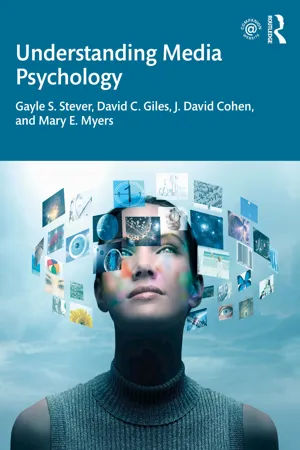
Understanding Media Psychology
- 326 pages
- English
- ePUB (mobile friendly)
- Available on iOS & Android
Understanding Media Psychology
About this book
Understanding Media Psychology is the perfect introductory textbook to the growing field of media psychology and its importance in society, summarizing key concepts and theories to provide an overview of topics in the field.
Media is present in almost every area of life today, and is an area of study that will only increase in importance as the world becomes ever more interconnected. Written by a team of expert authors, this book will help readers to understand the structures, influences, and theories around media psychology. Covering core areas such as positive media psychology, the effects of gaming, violence, advertising, and pornography, the authors critically engage with contemporary discussions around propaganda, fake news, deepfakes, and the ways media have informed the COVID-19 pandemic. Particular care is also given to addressing the interaction between issues of social justice and the media, as well as the effects media has on both the members of marginalized groups and the way those groups are perceived. A final chapter addresses the nature of the field moving forward, and how it will continue to interact with closely related areas of study.
Containing a range of pedagogical features throughout to aid teaching and student learning, including vocabulary and key terms, discussion questions, and boxed examples, this is an essential resource for media psychology courses at the undergraduate and introductory master's level globally.
Frequently asked questions
- Essential is ideal for learners and professionals who enjoy exploring a wide range of subjects. Access the Essential Library with 800,000+ trusted titles and best-sellers across business, personal growth, and the humanities. Includes unlimited reading time and Standard Read Aloud voice.
- Complete: Perfect for advanced learners and researchers needing full, unrestricted access. Unlock 1.4M+ books across hundreds of subjects, including academic and specialized titles. The Complete Plan also includes advanced features like Premium Read Aloud and Research Assistant.
Please note we cannot support devices running on iOS 13 and Android 7 or earlier. Learn more about using the app.
Information
1 Media and Media Psychology

In This Chapter
| • Introduction |
| • What Is Media? |
| • History of Media |
| • Digital Media and the 21st Century Versus Traditional Forms of Media |
| • Television, Then and Now |
| • What Is Media Psychology? |
| • Media Psychology Defined |
| • Media Literacy |
| • Convergence Theory |

Glossary
Introduction
What Is Media?
History of Media

Digital Media and the 21st Century vs. Traditional Forms of Media

Table of contents
- Cover
- Half Title
- Title Page
- Copyright Page
- Dedication Page
- Table of Contents
- Preface
- Acknowledgments
- 1 Media and Media Psychology
- 2 Key Theories and Concepts from Media Psychology
- 3 Research Methods
- 4 Positive Psychology, Moral Reasoning, and Prosocial Behavior
- 5 Social Justice and the Media: Gender, Class, and Disability
- 6 Social Justice and the Media: Race, Ethnicity, and Religion
- 7 Aliens Eating Reese’s: Media Influence and Advertising
- 8 Propaganda, Fake News, and Deepfaking
- 9 Processes of Audience Involvement
- 10 Dark Media: Violence, Pornography, and Addiction
- 11 Join the Adventure: The Psychology of Gaming
- 12 The Social Nature of Media
- 13 The Turbulent 20s: COVID-19 and the Media
- 14 The Future of Media Psychology
- Index